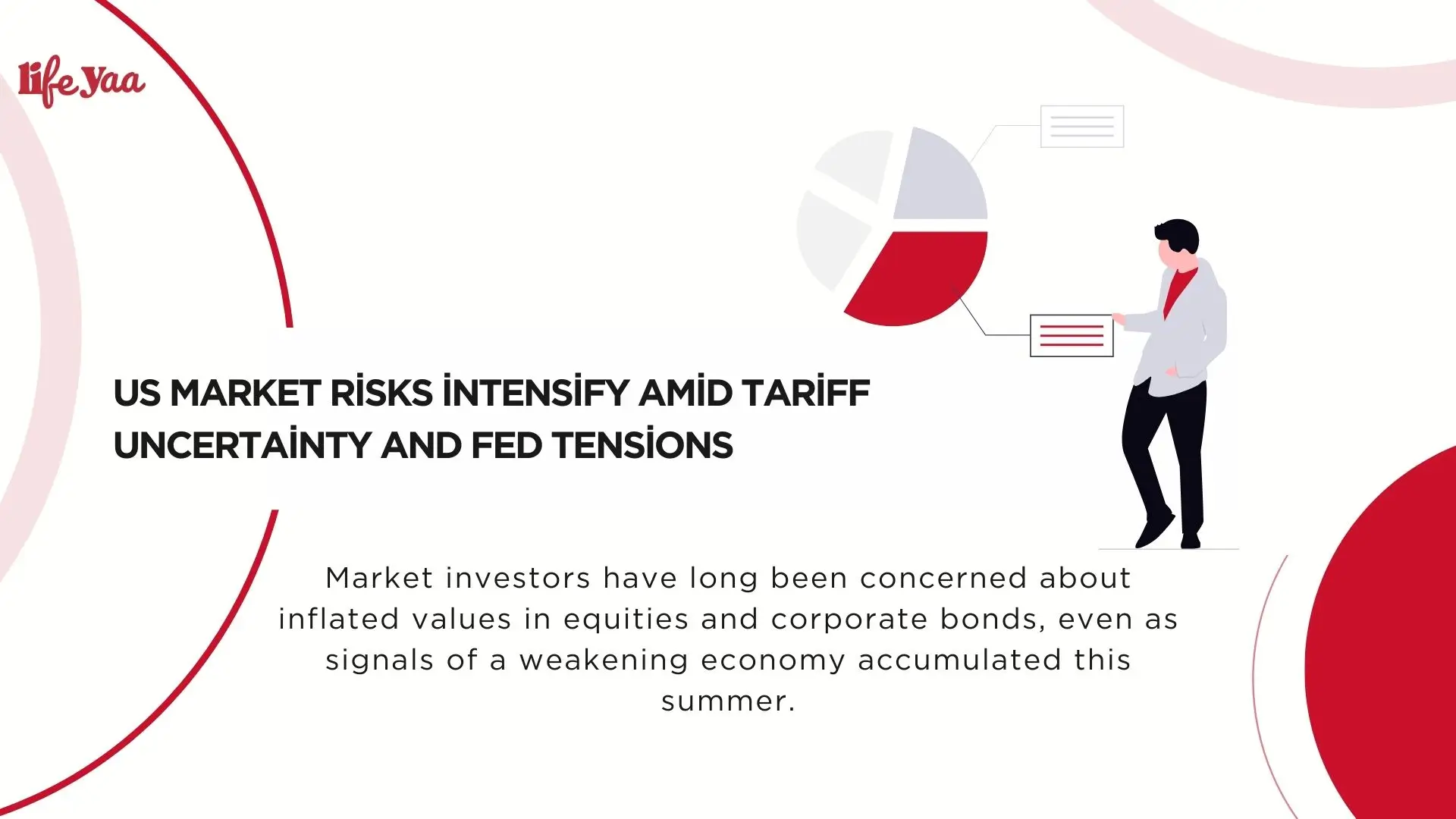The US market risks are back in the news now that Wall Street’s summer calm has been broken by the restart after Labour Day. The weak-seasonality reputation of September, along with debates about the Federal Reserve’s independence, tariff uncertainty, and rising Treasury yields, have shaken both stocks and bonds.
Investors are girding for heightened swings after Wall Street’s quiet summer snapped once trading resumed following the Labor Day break on Tuesday. With September’s track record as the weakest month for U.S. equities, worries about Federal Reserve independence and renewed uncertainty around President Donald Trump’s tariff stance coalesced, rattling both stocks and bonds.
US market risks intensify in the middle of tariff uncertainty and Fed tensions
Market investors have long been concerned about inflated values in equities and corporate bonds, even as signals of a weakening economy accumulated this summer.
Even if markets had seemed to take it in stride in recent weeks, a growing spat between Trump and the Federal Reserve sparked worries that the political strong-arming of the US central bank may tremble the US Treasury market.
Fresh questions over the legitimacy of Trump’s tariffs that surfaced during the holiday weekend rekindled those long-simmering fears on Tuesday. As a result, equities and bonds fell, and many market participants were expecting additional volatility ahead of Friday’s crucial employment data.

“We have some uncertainty around these tariffs, and that’s the trigger right now I think for the risk-off sentiment,” said Seth Hickle, portfolio manager at Mindset Wealth Management.
“The concern is that bond vigilantes will awaken and cause some chaos in the bond market, given the fact that we may have to send some of this tariff money back overseas,” he added, referring to bond investors who punish poor policies by dumping government debt.
The CBOE Market Volatility Index (.VIX), opens new tab, reached its highest level in over four weeks, while the S&P 500 (.SPX), opens new tab stock index, fell 0.7% on Tuesday. Long-term Treasury rates soared amid a worldwide bond selloff.
Benchmark 10-year Treasury rates, which climb when bond prices fall, increased by roughly five basis points to 4.269%, while 30-year yields reached their highest level since mid-July.
Rising rates may damage equities by making bond returns more appealing. Investors often look to 10-year rates of about 4.5% as a threshold at which demand for equities fluctuates.
They also tend to help the dollar, which recovered from recent losses on Tuesday.
Mark Luschini, chief investment strategist at Janney Montgomery Scott, said that the increase in 30-year Treasury rates to over 5% was “helping to put some pressure on the tape.” According to Luschini, the court verdict against Trump’s tariffs has raised concerns about the collection of tariff revenues in the US and their impact on reducing the budget deficit.
Chills in September
Seasonal decline may be due in part to investors returning from summer vacations cleaning up portfolios while also making tax and other changes before the end of the year.
According to the Stock Trader’s Almanack, September has been the S&P 500’s worst-performing month of the year for the previous 35 years, with an average fall of 0.8%. According to the Almanack, the index has decreased in 18 of the 35 Septembers, making it the only month that has fallen more than it has risen.
Christian Hoffmann, head of fixed income and portfolio manager at Thornburg Investment Management, said a risk-off move was widely predicted this month, with substantial debt issuance in credit markets on Tuesday compounding the selloff in government debt as investors shifted funds to corporate bonds.
“Our bias has been to be lightening up on risk through the summer as valuations ground tighter,” added the economist.
According to the ICE BofA Corporate Index, corporate bond spreads, or the premium over U.S. Treasury rates that highly regarded corporations must pay to borrow, were at their narrowest level ever last month at 75 basis points.
“Given the lack of volatility that we’ve been seeing and where spread levels were, it seemed like the more likely case was to have some more volatility,” according to Hoffmann.
Friday’s August employment report will be critical for investors in determining how aggressively the Fed will lower rates in the coming months, yet ongoing inflation pressures may restrict its capacity to rescue Wall Street.
This week’s confirmation hearing for Stephen Miran, a close Trump loyalist and his choice for an interim Fed position after Adriana Kugler resigned on August 1, will also be watched by investors. His appointment coincides with Trump’s intensifying assaults on the Fed, which include a campaign to fire Governor Lisa Cook and constant criticism of Chair Jerome Powell for failing to cut interest rates.
Josh Chastant, portfolio manager for public markets at GuideStone Funds, said, “The market sees the possibility of a less independent central bank and there’s going to be implications because of that.”
Alternative assets that can shield portfolios in erratic markets are also sought after by investors. On Tuesday, gold bullion reached a record high of almost $3,540 per ounce.
According to Aakash Doshi, head of gold strategy at State Street Investment Management, “both gold and bitcoin are up this year, not one or the other.”
He pointed out that when it comes to the US dollar, the two assets—one traditionally seen as a hedge and the other as a high-volatility strategy—converge. “Both provide an alternative to de-dollarization and fiat currencies.”
▾ ARTICLE SOURCES
We cite primary sources where possible and reputable publishers for context.
⚠️ Disclosure
